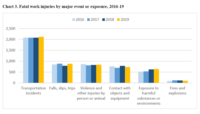Construction jobsite deaths rose in 2015 to their highest level in seven years and the industry’s fatality rate also edged up, the Dept. of Labor has reported.
The department’s Bureau of Labor Statistics said in its latest annual report on fatal workplace injuries, released on Dec. 16, that private-sector construction deaths climbed 4%, to 937, the most since 2008, when the industry recorded 975 fatalities.
BLS also said that construction’s 2015 fatality rate increased to 10.1 per 100,000 full-time-equivalent workers, from 9.8 in 2014.
The bureau said that a main factor behind the upturn in construction deaths is an increase in fatalities among specialty trade contractor firms. It notes that fatal injuries to workers in foundation, structure and building-exterior contractors were up 27% last year, to 231.
Construction groups say they are committed to working to bring down the fatality levels.
Brian Turmail an Associated General Contractors of America spokesman, says his group has been concerned about the safety impact of construction’s current labor shortage. As experienced workers leave the industry and less-experienced ones come on board, he says,“that poses a challenge” to safety, particularly when construction volume is up.
Turmail says, “We’re going to…redouble our efforts to make sure our members and other construction firms, have the resources they need to provide robust safety programs targeting new workers.”
He adds: “The endgame is zero fatalities a year. And we obviously have a lot of work to do. We’re committed to doing that work.”
The Associated Builders and Contractors "believes that one jobsite fatality is too many," Greg Sizemore, vice president for health, safety, and environment and workforce development, said via email.
Sizemore says that 'leading indicator" safety programs have been particularly effective. He says that the programs involve employee, subcontractor and supplier participants and include "in-depth new hire orientations, site-specific safety orientations, toolbox talks and site safety committees." Sizemore says a 2016 ABC report showed the programs have reduced recordable incidents by 86%, compared with the BLS industry average.
Chris Trahan Cain, deputy director of the union-affiliated CPWR—the Center for Construction Health and Safety, noted that there was a sharper increase in 2015 deaths of Hispanic construction workers. A CPWR Data Center analysis shows that fatal industries among foreign-born Hispanic or Latino construction workers rose 27% last year.
In an email, Trahan Cain agreed that there is an urgent need to continue construction's joint efforts to make workplaces safer.
She added that "we need to enhance safety and health protections and training, in particular for Hispanic immigrant workers, workers with specialty trade contractors and other worker groups at higher risk in this industry."
The BLS report also showed that total fatal on-the-job injuries were up last year, by less than 1%, to 4,836 from 4,821 in 2014. BLS said that number was the highest since 2008.
The overall fatality rate dipped to 3.38 per 100,000 workers, from 3.43 the year before.
The BLS report included final statistics for 2015. The agency had for years also produced preliminary annual reports on fatal injuries but will no longer do so.
Story updated on Dec. 23 with comments from CPWR



Post a comment to this article
Report Abusive Comment